The world of technology is rife with acronyms – and Unified Communications (UC) has more than its fair share.
In telecommunications, traditional phone usage has changed globally. Analog telephone lines will be obsolete by 2025 and those business communication systems that haven't already, will switch to internet and mobile interfaces.
While many business owners don't necessarily know all the technical aspects of enterprise communications, understanding Voice Over Internet Protocol (VoIP) technology will help to streamline an organization's unified communications system.

Image source: Bytes Digital
In this guide, we'll explain the fundamentals of SIP Trunking, the protocol used to connect and control communication during a VoIP multimedia session.
We'll cover the basics of how a SIP trunking system works, and demonstrate the limitations of an analog phone line that can only be used to make telephone calls.
We'll compare the physical connection against the virtual phone line, and explore the endless benefits of VoIP communications to today's unified communications and collaboration networks.
Table of Contents
What is PSTN and ISDN?
As an essentially 20th century technology, the Public Switched Telephone Network (PSTN) is all but obsolete, as it no longer meets the demands of 21st century business and unified communications.
Integrated Services Digital Network (ISDN) is one of the digital standards that uses the PSTN network, and while it was widely adopted by large enterprises over analog services, it too is now largely inadequate.
Voice over Internet Protocol (VoIP), is a cloud based technology that allows you to make voice calls using a broadband internet connection instead of a regular analog phone lines. It allows huge amounts of data traffic and call volume, and IP phones are cost effective for large or small businesses.
The table below shows a quick comparison of the different technologies.
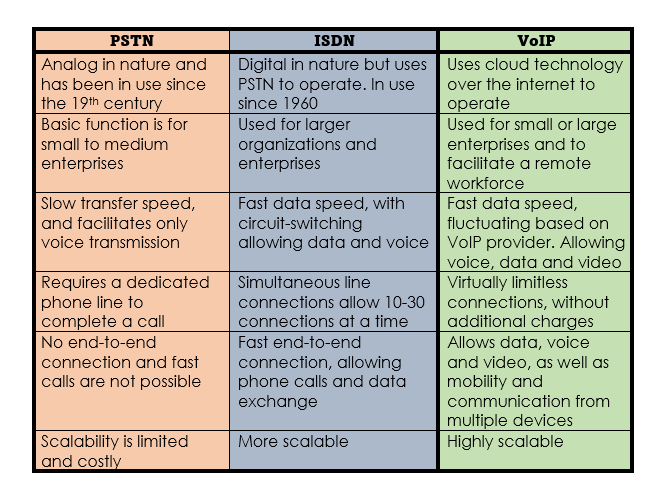
What is SIP trunking?
A trunk is essentially just another name for a phone line. SIP is just one of the possible protocols used for VoIP connectivity, and provides a way to convert voice signals into data that can be decoded by devices used by a caller.
Trunks refer to the groups of cabling that would link traditional phone systems from one local telephone exchange to another. With the internet, this process became virtual. A trunk is now a collection of assigned 'channels', which can each handle a set number of calls simultaneously.
How SIP Trunking works
IP phones are now the most common way for organizations to manage their communications network. SIP trunks are a replacement technology, and a modern alternative to the ISDN telephone network that transmitted data and voice digitally over physically wired connections.
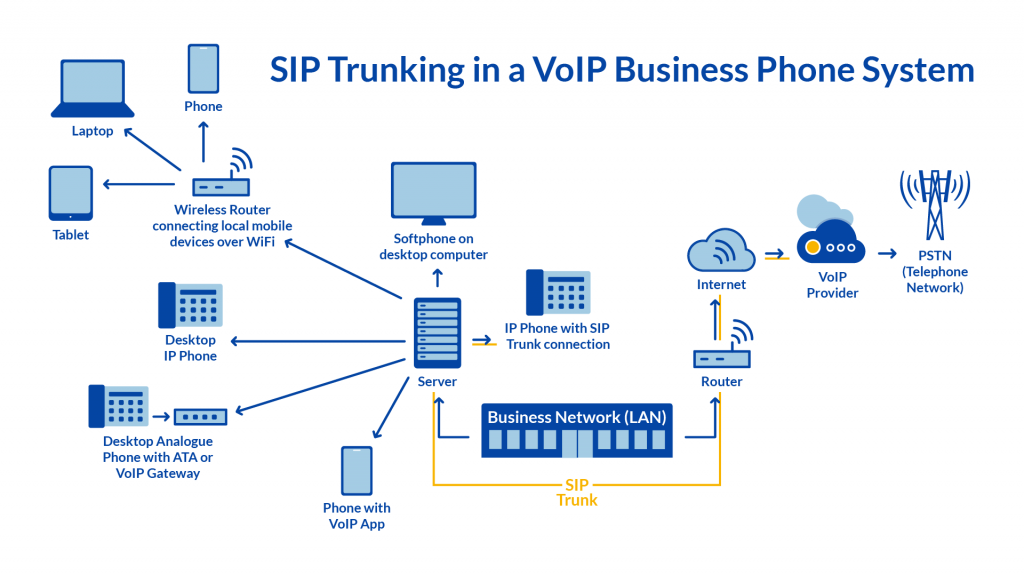
Image source: Nextiva
SIP trunks use the internet and IP network to allow businesses to set up outbound calls and inbound real-time audio phone calls and/or video communication sessions using the SIP application layer protocol.
SIP trunking requires an internet connection through an internet service provider, or a VoIP vendor, an IP-enabled PBX and a gateway to support IP-based phone calls and video communication.
Before VoIP technology, each trunk needed their own analog telephone lines, with physical copper wire phone system that connected a particular handset to the telephone lines outside the building and beyond. Adding a new phone required running a new wire, which meant cutting physical entry points in walls and floors.
SIP trunking architecture
With SIP trunking, all phone calls are transmitted over the internet instead, through an internet telephony service provider. This means you don’t have to use local phone companies or have a traditional phone line or landline provider; instead you simply add your phone system to your existing internet subscription and paying for bandwidth accordingly.

SIP providers are the companies that provides SIP services to customers, either delivered on-premises or hosted in the cloud.
Organizations typically lease a single trunk with a number of channels. It's then possible to add and remove channels as needed to meet employee demand and keep on top of costs.
A service provider either leverages services from a voice carrier to sell to customers or is both a service provider and a voice carrier. The best SIP trunking providers allow you to use your existing PBX equipment to transition to a virtual phone network.
The difference between SIP trunking and VoIP
VoIP is limited to transferring only voice data over the internet, while a SIP trunk enables the transfer of packets of multimedia data, including voice, text messages or video.
Additionally, a VoIP call can only be carried out over the internet or a private internal network. A SIP trunk, however, can be used to transfer data packets over any network, including the ISDN (physical phone network), a VPN, or the internet.
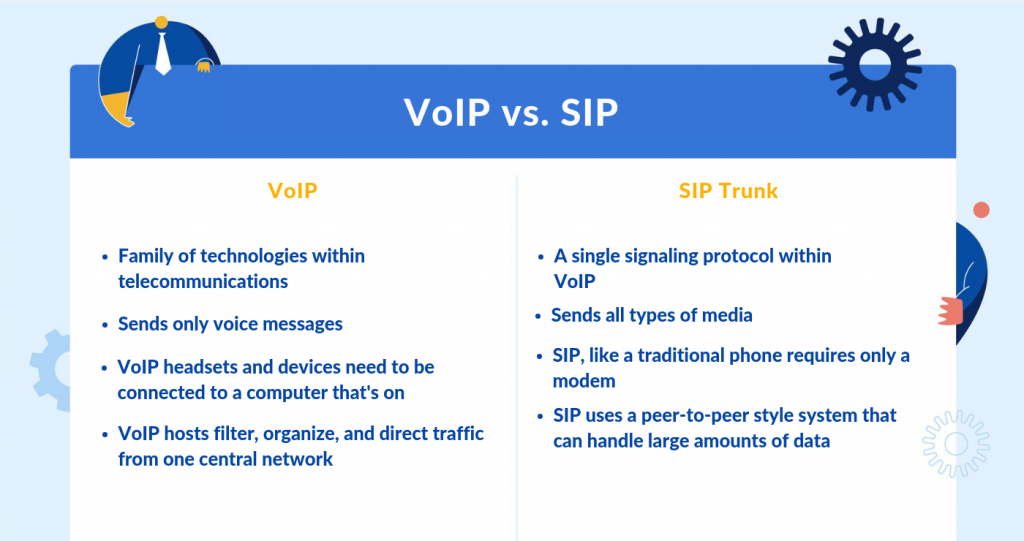
Image source: Nextiva
What are the benefits of SIP trunking?
As many businesses have already phased out analog telephony, the benefits of deploying SIP trunk are growing. SIP is a lightweight, flexible technology delivered via a SIP trunk provider, allowing businesses to reap the many benefits of internet-based phones. Let’s look at some of the benefits of IP telephony using SIP trunking.
Reduced costs of infrastructure and communication
Until SIP trunking became more mainstream, businesses had to contend with the crippling deluge of charges associated with traditional phone systems, including local, long distance calls and international calling. Not to mention installation costs of hardware, maintenance and upgrades. One study revealed that the average business switching to SIP trunk saved 50% per month.
-
SIP trunking providers use the internet instead of expensive physical phone lines
-
Long distance and international calls become local calls
-
A SIP trunking service pricing plan is easy to understand, and is usually billed on a per-user basis.
Immediate return on investment
Many businesses are reluctant to plunge into new technology investments, due to the fact that they don’t see a return on their investment - often for years. SIP trunking technology comes with minimal investment costs and is a well-established method of communication, enabling businesses to see cost savings from their first monthly bill.
Global potential, mobility and flexibility
The fast scalability of SIP voice and data services allows businesses to scale with maximum flexibility. This means massive benefits for businesses looking to expand their organizations across multiple geographic locations and enable more full-time remote workers.
SIP trunking consolidates voice services and data into a single network, combining and connecting offices and remote workers. As business needs change, users and bandwidth can be easily added and modified without risk or unexpected costs.
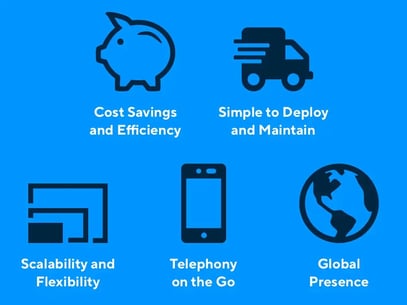
Increased business productivity
SIP trunks are a gateway towards Unified Communications as a Service (UCaaS). SIP trunk providers can offer a full gamut of communication tools like video conferencing, instant messaging, collaboration apps and voice integrations, moving them to a single, manageable platform.
With all your real-time communication handled from the one place, there is seamless connection between employees and offices – allowing for maximum efficiency and productivity.
Consolidating your network
Instead of paying for telephone voice services and data services separately, SIP trunking means that organizations can move their voice and data into a single network infrastructure, where voice calls become a form of data transmission. This can result in a significant saving, especially with fiber-optic internet connectivity.

Image source: Plum Voice
Reduced need for physical infrastructure
With more and more businesses moving towards a hybrid working culture, physical office space and physically wired network infrastructures are becoming less of a norm. Every business knows the frustrations and costs of waiting for traditional telecommunications companies to install new phone lines.
With SIP, businesses can add phone lines by simply connecting handsets to their data connection, Users working remotely can be easily integrated into the company network.
No additional costly hardware installation
With traditional telephony, referred to as Primary Rate Interface - or PRI phone lines, businesses often need to invest in costly additions to hardware as they scale their communications network. Increasing phone lines or add-on services is as simple as purchasing an additional handset and scaling SIP service agreements with SIP trunk providers
Reliability
Nothing impacts business continuity more seriously than a breakdown in communication services. While traditional phone services are notorious for glitches, many people think the same applies to internet telephony.
SIP trunking provides backup in the event of power outages or system failures. Your SIP provider will simply route calls to employees’ mobile devices or other destinations. The failover capabilities of a SIP trunk service keeps businesses up and running, creating far more reliability than a traditional PRI phone system.
How many calls can be made at the same time with SIP trunk?
With PRI, or traditional telephony, a trunk referred to a bundle of physical copper phone lines which were part of a building’s physical infrastructure allowing multiple lines to be shared between users. With modern SIP lines, this process becomes virtual. A trunk becomes a collection of assigned ‘channels’ which handle a set number of simultaneous calls.
You could think of SIP Trunk as a super highway where individual lanes are your SIP Channels, for a smoother business communication journey.

Image source: MachCloud
The number of channels you’ll require as a business is usually dependent on the size of your business, and how many concurrent calls you’ll likely be making and receiving at the same time.
Each channel allows one incoming and one outgoing call, but if your business receives a great volume of inbound concurrent calls, you’ll need a larger number of channels. Most medium to large businesses will benefit greatly from the flexibility and cost-effectiveness of SIP trunking.
SIP – the new era of telecommunications
Technology is evolving rapidly, but so too is our working culture. With remote and hybrid working now an accepted part of the way we do business, our communications infrastructure needs to be constantly updated. ISDN is now end-of-life technology.
Several countries worldwide have already made the switch to SIP, including the US, Australia, Belgium, France, Germany, Switzerland, Sweden – and the UK is set to switch off its ISDN in the very near future.
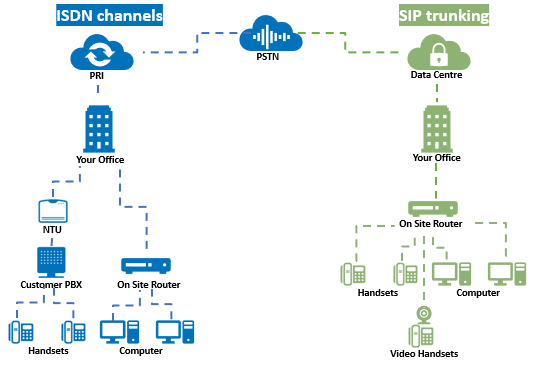
Image source: Nexus IP
This means that every business phone system currently using ISDN and traditional phone lines will need to migrate to SIP sooner rather than later.
What about bandwidth?
There are statistical models to help businesses know exactly how much capacity they will need at any time, considering peaks and troughs in call traffic.
Too little bandwidth results in blocked, abandoned or dropped calls, which in turn harms a business’s reputation. Finding the right SIP provider to help calculate initial usage needs will mean less chance of running out of bandwidth, as well as significant cost savings.
Why upgrade from ISDN to SIP Trunking?
With SIP technology, there are no on-site components, so IT staff are free to manage other parts of the business. SIP service providers use a proxy server to provision all incoming, outgoing and Private Branch Exchange calls, as well as taking care of technical support.
SIP trunking means that service and power outages are no longer an issue, as SIP trunks automatically reroute calls.
The flexibility of SIP trunking allows businesses with an international presence or remote workforce to stay in constant communication with staff and customers across the country, or the globe.H
How to choose a SIP trunking provider
For any company looking for a SIP provider, or placing any of their business communications in the cloud, security should always be the top priority. Other considerations are
Support - Working with a provider that offers first-class support means you won’t be without a phone line for long if anything goes wrong.
Communication - Work with a SIP provider that can give upfront explanations on what they provide - in plain English.
Pricing - Make sure you and your SIP provider are on the same page when it comes to what services they provide, and how much it will cost.
Connectivity - A strong, reliable connection is important is important, so make sure you discuss with your SIP provider whether you need to make any broadband changes.
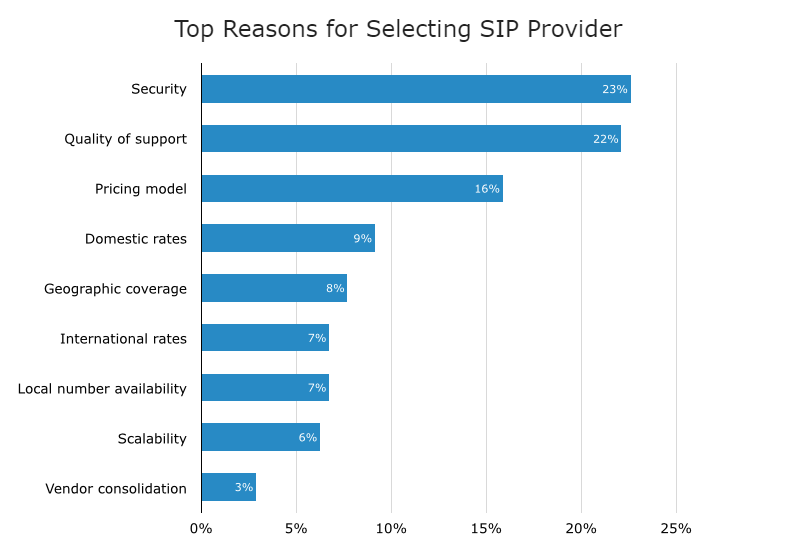
Image source: Software Advice
The importance of monitoring your SIP trunk channels
Remote and hybrid working is now the norm in the business world, and keeping communication channels up and running seamlessly 100% of the time is challenging.
The success and seamless operation of your communications infrastructure depends on pro-active monitoring and performance management solutions.
If you’ve already switched to SIP technology, or are in the process of migrating, it’s imperative that you have systems in place to perform detailed monitoring and troubleshooting tasks like:
-
Identifying the root cause of SIP call failures
-
Real-time VoIP traffic analysis
-
Correlating data on SIP trunk availability
-
Audio quality, video performance and corresponding network metrics
-
Alert generation
Find out more about SIP monitoring tools in our comprehensive guide here
IR Collaborate
IR’s solutions provide complete visibility across your entire UC ecosystem from a single pane of glass. Testing for, and identifying the root cause of voice traffic problems like packet loss, latency and jitter is crucial to keeping your communications network up and running.
Whether your environment is on-premises, in the cloud or hybrid, IR’s solutions enable you to monitor, troubleshoot, and optimize complex UC environments with ease and deliver the best user experience possible.





